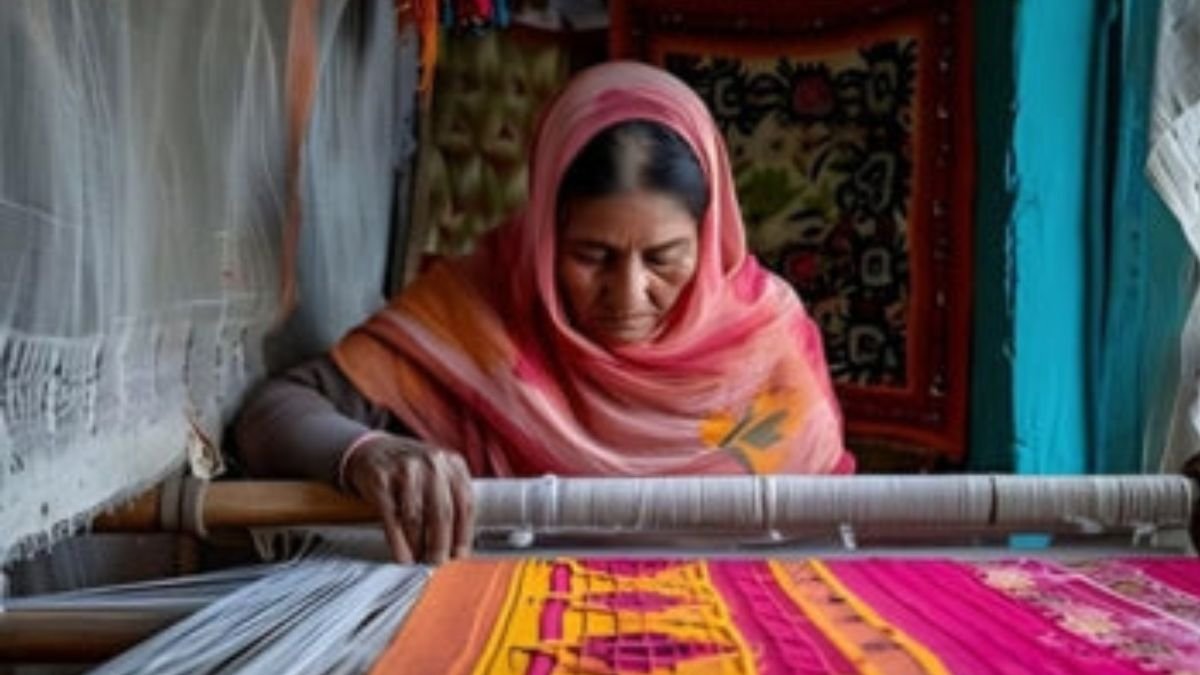
Handloom sarees have existed in the Indian subcontinent for over 5,000 years. Evidence of hand-spun and handwoven cloth was found in archaeological sites of the Indus Valley Civilization, including cotton fibers in Mohenjo-Daro. The use of the spindle and rudimentary loom setups marks the beginning of India’s handloom tradition. These early weaving practices laid the foundation for the sophisticated techniques we see in handloom sarees today.
Evolution Through Dynasties: Royal Patronage and Textile Trade
During the Maurya and Gupta periods, handwoven sarees became more refined due to royal patronage. The art of weaving flourished in centers like Varanasi and Kanchipuram. Under the Mughal Empire, Persian influence enriched saree designs with motifs like paisley, floral vines, and metallic thread work. This era also witnessed India’s rise in the global textile trade, with handloom fabrics being exported to Europe, China, and the Middle East.
Traditional Weaving Techniques of Handloom Sarees: Warp, Weft and Weavers’ Skill
Handloom sarees are woven on manually operated looms, using interlacing of warp (lengthwise yarns) and weft (crosswise yarns). The process begins with yarn dyeing, followed by warp setting, and intricate hand-weaving. The weaver’s skill defines the sharpness of motifs and tightness of the weave. No power machinery is used, making each saree a time-intensive, handcrafted piece. Techniques like extra weft, jacquard, and jamdani weaving add dimension and narrative to the fabric.
Handloom Saree Weaving Centers in India: Regional Artistry and Distinct Identity
Each region in India contributes its unique aesthetics to handloom sarees:
- Kanchipuram (Tamil Nadu): Known for rich silk sarees with temple borders, woven using mulberry silk and gold zari.
- Banarasi (Uttar Pradesh): Features Mughal-inspired motifs, brocades, and intricate cutwork using silver and gold threads.
- Sambalpuri (Odisha): Ikat technique with tie-dye patterns on warp and weft threads before weaving.
- Chanderi (Madhya Pradesh): Lightweight sarees woven with silk-cotton blend, known for transparency and delicate motifs.
- Assamese Mekhela Chador: Technically not a saree but often included, uses Muga and Eri silk with indigenous motifs.
- West Bengal’s Jamdani: Intricate muslin sarees where motifs are added individually with extra weft threads.
Each of these handloom centers preserves distinct weaving practices passed down through generations, contributing to India’s diverse textile identity.
Natural Fibers in Handloom Sarees: Cotton, Silk and the Rise of Eco-Friendly Weaves
Handloom sarees predominantly use natural fibers such as cotton, silk, tussar, and linen. Cotton sarees are lightweight and breathable, ideal for daily wear, especially in humid regions. Silk sarees, such as Kanchipuram and Banarasi, are favored for weddings and festivals. Recently, organic cotton, khadi, bamboo yarns, and Eri silk have gained attention for their sustainability, aligning handloom sarees with eco-conscious fashion movements.
Cultural Significance of Handloom Sarees: Beyond Clothing to Identity and Ritual
Handloom sarees are more than garments—they are symbols of cultural identity and heritage. Woven sarees are intrinsic to Indian rituals, religious ceremonies, and weddings. In regions like Kerala, the Kasavu saree is worn during Onam, while in Bengal, white-red bordered sarees mark Durga Puja traditions. Each piece is a bearer of stories, social practices, and regional pride.
Government Support and GI Tags: Preserving Handloom Heritage
The Indian government has initiated schemes such as the National Handloom Development Programme (NHDP) and Handloom Mark Scheme to protect and promote handloom artisans. Several handloom sarees have received Geographical Indication (GI) tags, including Kanchipuram Silk, Banarasi Brocade, and Baluchari sarees, legally recognizing their regional origin and authentic weaving methods. These efforts are crucial in safeguarding livelihoods and preventing counterfeit reproductions.
Modern Handloom Sarees: Fusion with Contemporary Fashion
In the 21st century, handloom sarees have found a stronghold in sustainable fashion and designer collections. Designers like Sabyasachi, Gaurang Shah, and Raw Mango have brought handloom sarees to global platforms by reinterpreting them in contemporary silhouettes. Urban consumers now prefer handloom sarees for their minimalist elegance, breathable fabrics, and ethical production. The saree is no longer restricted to tradition—it has evolved into a canvas for modern self-expression.
Challenges Facing the Handloom Sector: Decline in Weavers and Market Competition
Despite its richness, the handloom sector faces serious challenges. Low wages, lack of youth interest, and competition from powerloom and synthetic fabric industries threaten the sustainability of this craft. The COVID-19 pandemic further disrupted supply chains and sales. Revival depends on consumer awareness, government incentives, and e-commerce platforms that directly connect artisans with buyers.
Buying Authentic Handloom Sarees: Tips for Ethical and Informed Purchases
To support genuine craftsmanship, buyers should look for:
- The Handloom Mark issued by the Ministry of Textiles.
- GI-tagged labels for region-specific authenticity.
- Purchasing directly from government emporiums, certified handloom exhibitions, or weaver collectives.
- Recognizing signs of hand-weaving such as minor irregularities in weave and natural fiber feel.
- Conscious purchasing not only supports artisans but also helps preserve a cultural legacy.
